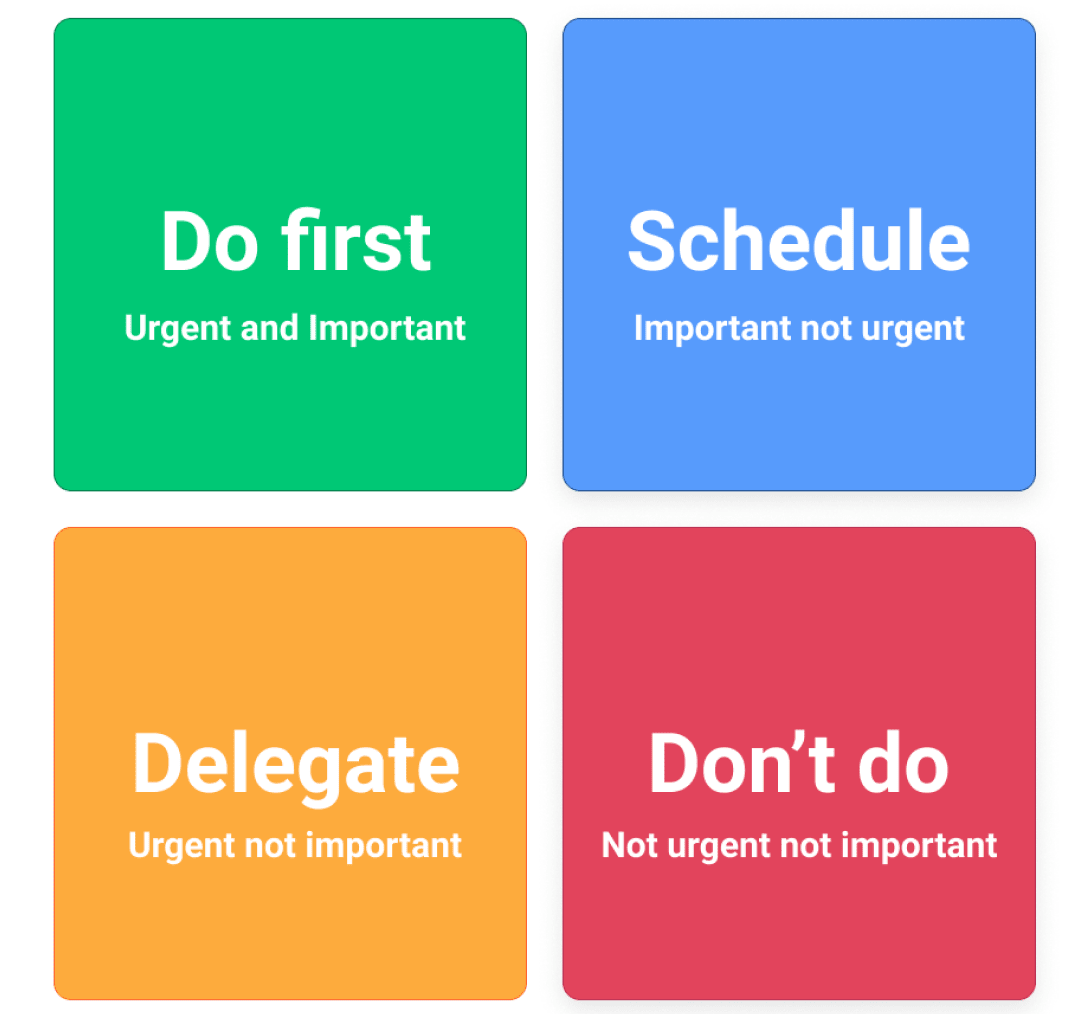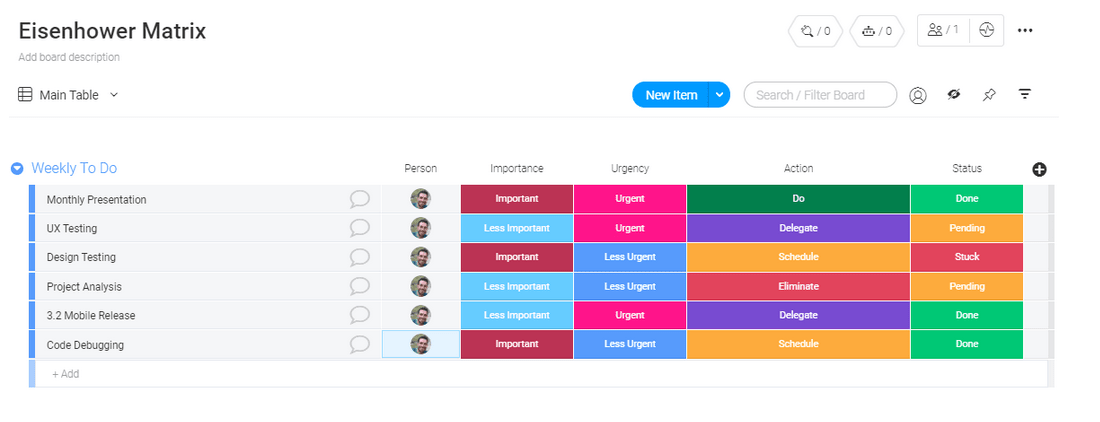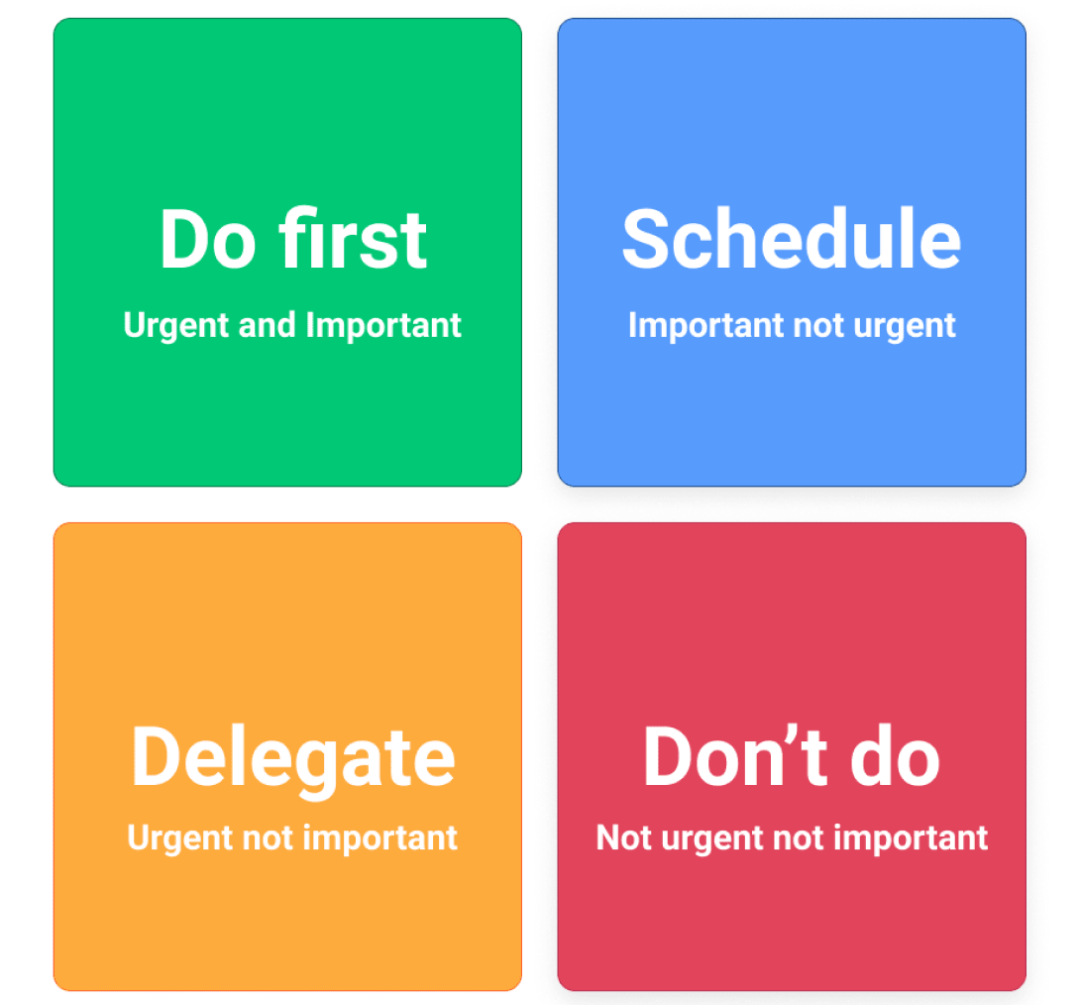How to prioritize your life and business with the Eisenhower Matrix
Blog: Monday Project Management Blog
Prioritizing. Even the word sounds overwhelming.
And, sometimes, prioritizing your life and business can feel more difficult than it truly is.
There are so many prioritization models, apps, and methods, they can end up feeling as though they’re weighing you down even more than you were before you started.
In this article, we’ll walk you through the secrets of prioritizing like a pro, warn you against the 3 enemies of prioritization, and introduce you to the secret sauce of prioritization: the Eisenhower Matrix.
What is prioritizing, really?
Prioritizing is the act of choosing which things are more important than other things.
It’s most often referenced in terms of a to-do list, but you can prioritize almost anything — big purchases, calls to friends and family members, your Netflix watch list — you name it.
In the business world, managers work to deprioritize efforts of low value in favor of ones that benefit the well-being of the team or better help you achieve your business’ objectives.
Developing the skills to prioritize one task over another is about more than determining value though.
It’s about the impact that choice will have on your life.
Pouring your effort into high priority tasks is crucial to making sure you use your time well.
Why is prioritizing so important?
Americans spend 7.9 hours per day at work — or about 33% of their weekday.
If you sleep 8 hours a night, that’s just as much time at work as it is personal time. In both cases, you’ll want to use that time wisely.
At work, the average office worker spends under 3 hours a day on important tasks, while wasting 2 hours on non-productive “stuff.”
Prioritizing helps.
Spending effort on work that is actually important — instead of what “feels important” — means that every minute of your workday has value.
It also means you have less work to take home, less of a backlog of important tasks, and more personal time you actually get to spend on yourself.
How the Eisenhower Matrix makes prioritization easy
In a 1961 address to the Century Association, President Eisenhower laid the foundation for 21st-century prioritization:
“Who can define for us with accuracy the difference between the long and short term? Especially whenever our affairs seem to be in crisis, we are almost compelled to give our first attention to the urgent present rather than to the important future.”
Eisenhower’s skill at prioritizing tasks led business experts to develop a simple prioritization tool in his honor.
The Eisenhower Matrix is a no-nonsense, streamlined method for determining the urgency and value of every task in your life and business.
Also known as the Eisenhower Decision Matrix and the Urgent-Important Matrix, it guides its users towards prioritizing tasks based on urgency and importance.
It looks like this:

The Eisenhower Matrix (available as a monday.com template) divides every task into 4 quadrants, therefore organizing your to-do list.
Let’s break those 4 quadrants down…
Quadrant 1: do (urgent and important)
When something is both urgent and important, it should be at the top of your to-do list. Think things like deadlines, emergencies, and crisis situations.
Some examples might include:
- Taking the Thanksgiving turkey out of the oven before it burns before you set the table
- Prepping for the meeting you have in 15 minutes
- Reallocating employee time away from innovative projects to fix your product’s recent recall
Quadrant 2: schedule (important, not urgent)
These items will make a big impact, but aren’t weighing on your conscience. Get them scheduled for later so you know you have time for them.
These might be things like:
- Getting around to your workout
- Watching an online course that will bolster your skills (either personally or professionally)
- Allocating time for your employees to partake in cross-functional projects in support of their professional development
Quadrant 3: Delegate (urgent, not important)
This quadrant includes all of your squeaky wheels—they’re urgent tasks, but aren’t necessarily going to make or break you or your team. If you can delegate here, you should.
A few examples:
- Hanging holiday decorations around the house
- Being a second pair of eyes on your boss’s next LinkedIn article, which he asked you to edit as a favor
- Small bug fixes in your customer service automation that are slightly but negatively impacting your churn rate
Quadrant 4: Don’t do (not urgent, not important)
- Catching up your social media feed
- Taking a sales demo for a product you know you’ll never buy, just for the gift card
- Creating products or features “just because your competitor did” without a plan to impact revenue
The ability to separate your daily tasks and long term plans into these 4 categories is powerful. If you’re just starting out with the Eisenhower Matrix Template, be as objective as possible with how you analyze your tasks.
Look closely at how you define the words urgent and important when it comes to prioritizing.
The “mere urgency effect:” when everything seems urgent, how do you determine what to do?
A study called “The Mere Urgency Effect” found that humans tend to be positively biased towards time-sensitive tasks, even if those tasks are not in our best interest.
It’s why a simple to-do list will ultimately let you down.
The Eisenhower Matrix forces you to schedule those tasks that are important but not urgent.
The act of setting aside time on your calendar for these tasks makes it more likely you’ll get to them, and allows you to prioritize them before more urgent tasks inevitably surface.
How to get started with the Eisenhower Matrix
The Eisenhower Matrix is best used when you’re overloaded with tasks.
To get started prioritizing your tasks or your team’s tasks using this method, follow these steps:
- Make a huge, unorganized list of tasks. In order to properly categorize your to-do list, you need to see the whole picture, and that means every to-do list item no matter how big or small.
- Choose your method for recording your prioritization. Sure, you could just draw the matrix on a piece of paper, but that’s not dynamic and won’t work with you as priorities inevitably shift. And, even more frustratingly, your team won’t be able to collaborate on its creation or maintain it going forward. Instead, find a digital platform to support you (like monday.com).
- Take stakeholder feedback into consideration. Before assigning items to an area of your matrix, collect input from relevant stakeholders on where tasks fall between important and urgent.
Once you’ve created your prioritized plan of action, plug it into the Eisenhower Matrix Template and track your results.
Prioritizing made simple with monday.com’s Eisenhower Matrix Template
The goal of monday.com’s Eisenhower Matrix Template is to make prioritizing simple.
In our (humble) opinion, this template knocks that goal out of the water while also taking things a step further — you can use monday.com to track the progress of each task and line item from ideation to completion.
It looks like this:

Here’s how it does that:
- Sorts your tasks in a streamlined, easy-to-read list (by quadrant!).
- Assigns each task to yourself or the appointed member of your team.
- Color codes each task by importance and urgency.
- Based on each color code, labels each task as Do, Delegate, Schedule or Eliminate.
- Tracks task and goal progress with live status reports.
- Reorders your tasks based on priority and completion status.
Plus, your team will actually be excited to use it to track their progress. The vivid color scheme of the Eisenhower Matrix Template keeps you and your team focused, prioritized, and on schedule.
monday.com goes the extra mile by keeping all communication in one place, which is key in the workplace. A study of good project managers listed 5 data-driven measurement methods for analyzing project manager performance. The first measurement listed was communication.
A direct, clear prioritization tool is important to delivering and analyzing information. Why wouldn’t you take advantage of this one?
Take the stress out of prioritizing your daily, weekly, and long-term tasks and goals — but make sure you avoid the enemies of good prioritization along the way.
Don’t fall into these 3 prioritization traps
Even prioritization masters fall victim to these traps:
- Subjectivity
- Vague goals
- Solo work
Let’s define each of them and walk through how to catch yourself in the act and course correct on the spot.
1. Subjectivity
Subjectivity is the act of being influenced by personal feelings, tastes, or opinions. If those things incline you to prioritize some tasks over others, you might not truly have achieved optimal productivity.
Subjective bias is a leading killer of smart planning.
It’s also the biggest roadblock to curating a good Eisenhower Matrix — or any other prioritization tool.
Why?
Because we’re fallible — human.
We prioritize things based on our own desires, rather than based on what actually needs to be prioritized.
So how do you make sure you’re being as objective as possible when prioritizing?
Here are some ideas for the workplace:
- Work with prioritization tools — like monday.com — to increase focus on shared values and goals within a team or a group of people. Tools like this help to automatically push individual “blind spots” to the rear.
- Be transparent about what tasks are on the table. Set time aside at the beginning of every prioritization meeting for each team member to detail tasks and goals.
- Encourage friendly question-and-answer interaction to challenge any potential subjectivity in the system.
And one solid piece of advice for both your professional personal life…
Get feedback from those around you.
Psychologist Catherine Moore notes that obtaining feedback on our goals acts as a roadmap for personal progress. As an added bonus, good feedback releases dopamine into our brains.
Feedback can come from other people, of course. But it’s also attainable through strong prioritizing tools like the Eisenhower Matrix. Honest self-appraisal of task progress and goal setting is key to achieving balance in your personal life.
2. Vague goals
In the past, we’ve identified setting clear goals as the secret to effective teamwork. If your goals aren’t clear, prioritization becomes impossible because what’s “important” will always come down to a subjective feeling.
Whether you are working with a business team or on personal goals, you need to establish context, in the form of clear goals, for your work.
How can you identify clear goals?
Here are some ideas for the workplace:
- Get feedback from senior management and stakeholders from other teams about what they see as the top priority in the coming quarter or year.
- Determine what key performance indicators (KPIs) will be used to measure those priorities (like revenue, employee churn rate, customer engagement, etc.)
Determine which tasks on your plate directly impact those goals.
If everyone within the organization doesn’t understand where you’re going and why, there will not be a unanimous effort to get there.
The process is similar for your personal life:
- Talk to key stakeholders in your personal life (like your partner, kids, or parents) about your personal path.
- Identify what you’ll need to measure to be able to achieve those goals (like a savings or career goal).
- Determine which tasks directly affect those goals and prioritize from there.
3. Solo work
Working alone is the third enemy of prioritization.
Linn Stuckerbruck, author of the aptly-named “The matrix organization,” tells us that the matrix only works when everyone is on board.
Amazing project achievement is found when team members become “believers,” Making your team and trusted advisors believe in your priorities takes clarity, objectivity, and openness.
In life and business, not nurturing a strong team can lead to project failure.
So, how do you get everyone on board?
In both the workplace and your personal life, you only need 2 things:
- Include all stakeholders in the conversation from the outset. They should have a say in defining goals and building the task list.
- Once you’ve completed your matrix, enlist their feedback before you decide your priorities are set in stone.
Strong individuals can perform well, but it takes a strong, cohesive team to win at prioritizing.
The Eisenhower Matrix is your key to effective prioritizing
You’ll need to be clear, concise, and direct about your goals. There will need to be strong reasons for every task. Prioritizing your tasks with the Eisenhower Matrix can help.
It’s time to step into the Eisenhower Matrix Template and become the king of prioritizing your life and business.
The post How to prioritize your life and business with the Eisenhower Matrix appeared first on monday.com Blog.
Leave a Comment
You must be logged in to post a comment.








